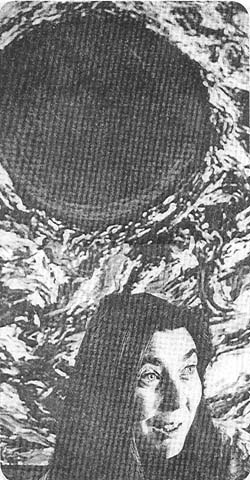|
|
|||||
| Atticus |
THE SUNDAY TIMES, 13 APRIL 1969 |
||||
| Making the break MARY BARNES paints madness from the inside looking out. Three years ago, in the grip of a severe mental breakdown, she regressed to babyhood?feeding from a bottle, adopting a wooden chest stowed in a cellar as a substitute womb. This week an exhibition of her paintings, documenting her collapse and her return to sanity, is on show at the Camden Arts Centre in London. They are not comfortable pictures. They show crosses, flaming suns, mountains, and curdled clouds. "What they represent" says Dr Joseph Berke, an American psychiatrist who prompted the picture-making in the first instance, "is Mary herself and an incredible experience she 'has been undergoing. It is nothing less than death and rebirth." |
|
||||
| Mary Barnes is forty?six. She was, trained as a nurse, became a ward sister
In a T B hospital, and turned Roman Catholic. " I was dissatisfied with the hospital routine. It was like
being inside a huge machine. I sympathised with the patients. They hardly had time to die." For a time she
entered a Carmelite convent, and was persuaded to go to a nursing home where she looked after breakdown patients.
" What I didn't realise at first was that I was in the same situation. "Finally, I did break up. I wound up in a mental hospital in the chronic ward. I was given E C T and insulin treatment. In my padded cell I just wanted to lie in the dark alone." A psycho?therapist, Dr Theodore Werner, took her away from the hospital, and, incredibly, she recovered sufficiently to study for two years at Hull University where she was awarded a teacher's diploma. " I took teaching posts .at hospitals, but I knew I was just sitting on my troubles. I knew that I needed analytical help?but no one would take me on." Eventually, she was accepted as a patient by the psychiatrist, Dr R. D. Laing. "I went to live at Ronnie's centre, Kingsley Hall, in Bow. And gradually I managed to overcome my own resistance. I allowed myself to break down completely. I became a baby again. When I wanted food they bottle-fed me. There was a great big wooden box in the cellar, and for me this became a womb. I used to go there and hide away with dolls and a teddy." She found speech impossible, contact unbearable. "I took to my bed for four months until Joe (Dr Berke) got me out. He would sit me in a chair and I would stay there for hours until he moved me again. One day Joe gave me a set of 'grease crayons and told me to scribble something. I did, on and on. Suddenly a picture emerged, a woman kneeling with a baby at her breast. I found some tins of paint, left over from decorating, and I painted picture stories about mermaids, tramps and children on the back of old wallpaper. I was moved to a room on the roof, and I painted a triptych on the walls. All my insides were loose. The painting, like lightning, was streaking from the storm. I painted the crucifixion again and again. I clung to the word "Resurrection". There was no sudden cure. There were violent relapses. But the methods of Laing and Berke letting the breakdown run its course without using drugs to suppress it finally succeeded. "I still don't want to go out in the world. But I am well occupied here painting and writing". She has, in fact just completed a book on her experiences at Kinglsey Hall, and Hutchinson are publishing it next year. Combined with the pictures it must be the complete first-person account of breakdown and recovery in psychiatric history. The pictures on show at the Camden Arts Centre are for sale. "But what they're really there for is to tell people what it was like. I want to help whoever needs it and understanding is the best kind of help to offer". |
|||||

